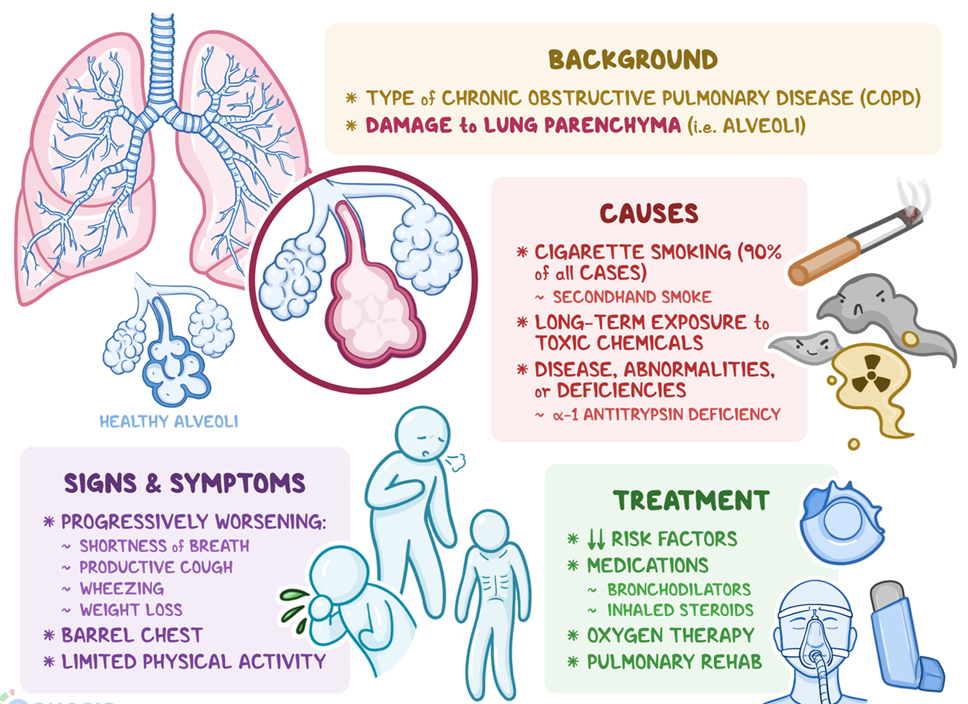A nurse is caring for a client who has COPD. Which of the following actions should the nurse take?
Encourage the client to drink 8 glasses of water a day.
Instruct the client to cough every 4 hr.
Provide the client with a low protein diet.
Advise the client to lie down after eating.
The Correct Answer is A
A. Encourage the client to drink 8 glasses of water a day.
This is the correct choice. Clients with COPD often have thickened respiratory secretions due to chronic inflammation and mucus production. Adequate hydration helps to keep these secretions thin, making them easier to cough up and clear from the airways. Encouraging the client to drink plenty of fluids, such as water, can assist in maintaining optimal hydration levels and promoting effective airway clearance.
B. Instruct the client to cough every 4 hours.
Instructing the client to cough on a scheduled basis, such as every 4 hours, is not appropriate for managing COPD. While coughing is important for clearing respiratory secretions, the frequency of coughing should be based on the client's individual needs and symptoms. Some clients with COPD may need to cough more frequently, while others may need to cough less often. It's important to encourage the client to cough as needed to clear secretions rather than on a predetermined schedule.
C. Provide the client with a low-protein diet.
Providing the client with a low-protein diet is not recommended for managing COPD. Adequate protein intake is important for maintaining muscle strength, including respiratory muscles, and supporting overall health. Clients with COPD may have increased energy needs due to the increased work of breathing and should be encouraged to consume a balanced diet that includes adequate protein.
D. Advise the client to lie down after eating.
Advising the client to lie down after eating is not recommended for managing COPD. Lying down after eating can increase pressure on the diaphragm and make breathing more difficult, especially for individuals with compromised lung function. It's generally recommended for individuals with COPD to remain in an upright position after eating to minimize respiratory discomfort and reduce the risk of aspiration.
Nursing Test Bank
Naxlex Comprehensive Predictor Exams
Related Questions
Correct Answer is ["A","B","D"]
Explanation
A. Dyspnea: Dyspneais a hallmark symptom of emphysema. As lung function deteriorates, the client experiences difficulty breathing, especially during exertion, due to reduced gas exchange and air trapping in the lungs.
B. Barrel chest:A barrel chest is a common finding in emphysema due to hyperinflation of the lungs over time. This causes the chest to become rounded and expands the anterior-posterior diameter of the thorax.
C. Clubbing of the fingers: Clubbing of the fingers is not a typical finding in emphysema or COPD. It is more commonly associated with conditions like lung cancer, cystic fibrosis, or congenital heart disease, where chronic severe hypoxia is present.
D. Shallow respirations:Clients with emphysema often exhibit shallow respirations as their lung elasticity decreases, making it difficult to fully exhale. As a result, breathing may become more rapid and shallow to compensate for poor oxygen exchange.
E. Bradycardia: Bradycardiais not typically associated with emphysema. Instead, clients with chronic respiratory conditions like emphysema may experience tachycardiaas the body tries to compensate for low oxygen levels.

Correct Answer is B
Explanation
A. Metabolic acidosis
Metabolic acidosis is characterized by a low pH (< 7.35) and a decreased bicarbonate level (< 22 mEq/L). In this scenario, the pH is low (7.22), but the bicarbonate level is elevated (28 mEq/L), which does not support a diagnosis of metabolic acidosis.
B. Respiratory acidosis
Respiratory acidosis occurs when there is an accumulation of carbon dioxide (PaCO2 > 45 mm Hg), leading to a decrease in pH (< 7.35). In this case, the pH is low (7.22), and the PaCO2 is elevated (68 mm Hg), consistent with respiratory acidosis.
C. Metabolic alkalosis
Metabolic alkalosis is characterized by a high pH (> 7.45) and an elevated bicarbonate level (> 26 mEq/L). In this scenario, the pH is low (7.22), and the bicarbonate level is also elevated (28 mEq/L), which does not support a diagnosis of metabolic alkalosis.
D. Respiratory alkalosis
Respiratory alkalosis occurs when there is a decrease in carbon dioxide (PaCO2 < 35 mm Hg), leading to an increase in pH (> 7.45). In this case, the pH is low (7.22), and the PaCO2 is elevated (68 mm Hg), which is not consistent with respiratory alkalosis.
Whether you are a student looking to ace your exams or a practicing nurse seeking to enhance your expertise , our nursing education contents will empower you with the confidence and competence to make a difference in the lives of patients and become a respected leader in the healthcare field.
Visit Naxlex, invest in your future and unlock endless possibilities with our unparalleled nursing education contents today
Report Wrong Answer on the Current Question
Do you disagree with the answer? If yes, what is your expected answer? Explain.
Kindly be descriptive with the issue you are facing.
